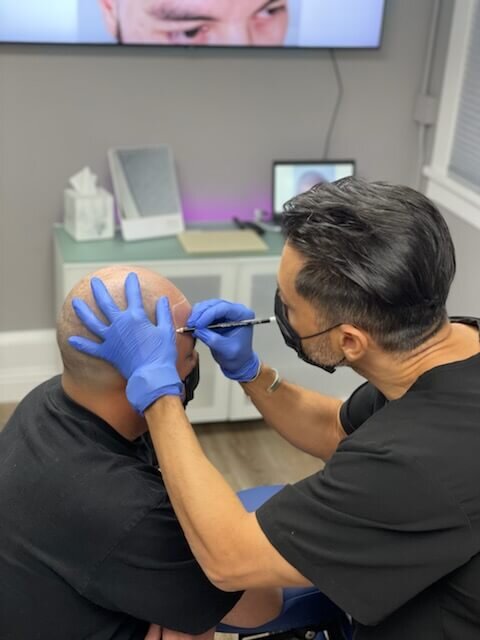Before you sink several thousand dollars into a hair transplant...
Male Pattern Baldness
(also called androgenetic alopecia) affects roughly 50 million men in the United States. Consequently, treatments for baldness range from specialized shampoos to complex surgeries.
But before you sink several thousand dollars into a hair transplant, you'll want to understand the potential risks and drawbacks. After all, hair transplant risks include severe scarring and widespread infection.
Before you go under the knife, be sure to check out these risks.
What Are Hair Transplant Risks and Side Effects?
Hair transplants are almost always surgical procedures, and consequently, they can pose certain risks.
Sensitivity to local anesthesia might be one of the more mild potential side effects of undergoing a hair transplant treatment. However, some of the more severe risks include permanent scarring, infection, and tissue death.
But to come to grips with the true harm that hair transplants can cause, it's crucial to examine the most popular types of transplants and their distinct dangers.
Types of Hair Transplants
To better understand the risks associated with hair transplants, we'll need to take a closer look at the two most popular types of hair transplant procedures:
FUE Hair Transplants, and
FUT Hair Transplants
This way, you'll have a comprehensive understanding of how these treatments can go wrong. Then, armed with this information, you can make a smarter choice about your own hair loss treatment plan.
FUE Hair Transplant Risks
FUE stands for follicular unit extraction (or excision). This type of treatment involves the careful removal and reintegration of hair follicles. This often involves surgically removing each hair strand, healthy root still attached.
The physician then takes the live hair and transplants it to the bald area of the scalp. This procedure can be time-intensive and result in a week-long recovery process. Still, it's a relatively popular option.
While this procedure is generally considered safe, some patients can experience severe post-operation side effects. Some of the most common risks associated with FUE transplants include:
Bruising
Swelling
Mild Pain
Small Tissue Scars
However, patients can also develop infections in their skin tissue or even skin tissue death. In some cases, hair transplant recipients can also develop severe and noticeable scarring near the surgery site.
FUT Hair Transplant Risks
FUT stands for follicular unit transplantation. This hair transplant procedure is slightly more invasive than FUE treatments. That's because FUT involved whole grafts of skin being cut and transplanted along the scalp.
This type of hair transplant often leaves much more noticeable scars than FUE procedures. And it can also be far riskier, due in no small part to the fact that it requires live bits of your skin to be removed and reattached.
Infections and unexpected bleeding are just a few of the potential side effects of this procedure. In addition, some patients also experience long-term pain or complete loss of feeling around their scalp.
How Much Does a Hair Transplant Cost?
The average hair transplant costs several thousand dollars. But some cost $15,000 or more! And because this type of procedure is often considered cosmetic, most forms of health insurance won't cover the costs.
That's a lot of money to blow on something that could leave you physically (and mentally) scarred for life. Fortunately, there are quite a few alternatives to hair transplants that are more than worth a second look.
Alternatives to Traditional Hair Transplants
There are several treatment options you can pursue that won't require you to go under the knife. Some of the most tried-and-true hair growth treatments include:
Supplements and Medications
PRP
SMP
While new procedures are constantly emerging, these three options have proven relatively effective for millions of people. Naturally, the right option for you depends on your type of hair loss, budget, and preferences.
Supplements and Medications
Hair loss is often considered a natural part of aging. However, it can also indicate nutritional deficits or hormonal changes.
Men with low testosterone levels, for example, may begin to lose large patches of hair. And women undergoing menopausal changes may find that when their estrogen levels drop, so does their hair.
Fortunately, several supplements can help boost natural hormone levels in both men and women. There are also several prescription drugs available that may help you grow thicker, stronger hair.
Of course, if supplementation or strong pharmaceuticals don't feel right for you, PRP is always an option. However, this hair loss treatment does involve needles.
PRP
PRP, or platelet-rich plasma, is a procedure that's used for a wide variety of purposes. However, its primary benefit is helping cellular tissue heal at a rapid rate. As such, it may help your dying hair follicles revive themselves.
This type of procedure is often best when used on men in the earliest stages of hair loss. That's because it's designed to help boost the health of ailing follicles. Unfortunately, it cannot create new, perfectly healthy follicles.
SMP
SMP, or scalp micropigmentation, is a form of tattoo that can last for several years. It involves the careful placement of small inky droplets along your scalp, creating the illusion of a fresh head of growing hair.
While this procedure does involve needles, it's considered a minimally invasive treatment. Additionally, patients can expect far shorter recovery times than if they underwent a hair transplant.
Scalp micropigmentation is a solid option for men with receding hairlines or total baldness. However, the length of your treatment session (or sessions) depends on your current hair loss level and desired outcome.
Embrace Your Look With Confidence
Hair transplant risks range from mild pain and swelling to widespread systemic bacterial infection. So before you get a hair transplant, you'll need to ask yourself, "Is my overall health worth a few extra strands of hair?"
After all, several alternative treatment options are far less risky and way more affordable. SMP (or cosmetic hair) is one such potential treatment. With the right artist, you could become far more confident.
If you're ready to try SMP for yourself, don't hesitate to contact us today! We look forward to helping you regain your confidence.

